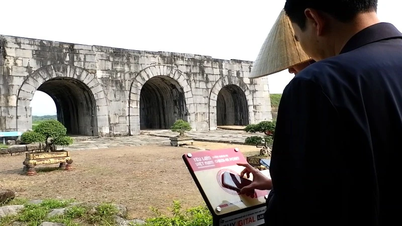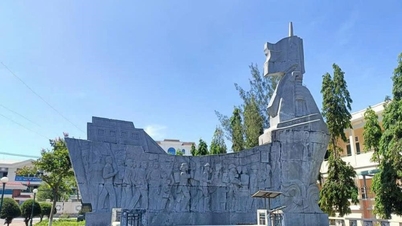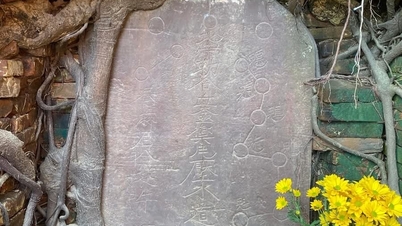
The initial excavation identified the true appearance of the Ho Dynasty Citadel's ground plan in the gate and wall area.
The Ho Dynasty Citadel Heritage Conservation Center (Department of Culture, Sports and Tourism of Thanh Hoa province) has just coordinated with the Vietnam Institute of Archaeology to organize a conference to announce the "front line" area inside and outside the 4 gates (East - West - South - North) of the Ho Dynasty Citadel heritage, with a total area of 5,000m2 (of which the North gate location is 2,000m2, the South 2,000m2, the East 500m2, the West 500m2), implemented from September 15 to December 31, 2022.
The excavation results have clarified the original dimensions of the gates at the Ho Dynasty Citadel. These rolling gates were built by piling up soil into the shape of an arch, then assembling trapezoidal stone blocks shaped like grapefruit segments on top. After assembling the stone slabs, the soil was processed outside. The structure of the three walls of the East, South, and West citadels is similar in size and stone assembling technique. The most typical is the East citadel wall, at the bottom are large-sized foundation stones, above are 4 to 5 rows of large-sized stones that are smoothed, the bottom row is the largest and gradually gets smaller; inside is a system of reinforced stone and gravel (the reinforced soil wall inside). Meanwhile, the stones arranged in the North wall and gate are smaller in size, have larger joints, more rows of stones, the outer stone layers are not smoothed, the inner stone layers are not chiseled into squares. This is partly due to the material processing process and partly due to the repeated restoration process in the later stages.

The Royal Road alone still has clear traces of a green stone embankment and slate paving located in the middle of the South Gate of the Ho Dynasty Citadel, facing North - South, connecting directly to the South to the Nam Giao relic connecting to the North of the road leading to the center of the inner city. The inner city area discovered traces of a road with 1 lane 4.65m wide and the remaining about 16m towards the inner city (the area outside the South gate has 3 lanes, the main lane in the middle of the South gate is 4.8m wide and 2 side lanes on both sides are 3.1m wide. Thus, it can be seen that the Royal Road of the Tay Do citadel during the Ho Dynasty is only in the best condition in the area before and inside the South gate. Regarding architectural materials, some types of rectangular bricks, decorated with Bodhi leaves from the Tran Ho Dynasty, flat tiles, and gray curved tiles from the Le Dynasty have been found. Regarding ceramics, the excavation pits found quite a lot of ceramic pieces from the Tran Ho Dynasty and the Early Le Dynasty. In addition, some clusters of marbles and stone bullets were also found in the area of the South and North gates.
Representatives of the Department of Cultural Heritage, the Department of Culture, Sports and Tourism of Thanh Hoa and scientific researchers recommended that the Ho Dynasty Citadel Heritage Conservation Center, based on UNESCO's recommendations, the Thanh Hoa Provincial People's Committee's commitment, and the Law on Cultural Heritage, develop conservation research plans in the following years and submit them to competent authorities for consideration and approval. In the immediate future, it is necessary to develop urgent protection and conservation plans for archaeological relics in order to best promote the value of the Ho Dynasty Citadel World Heritage. According to Associate Professor, Dr. Dang Van Bai, Vice Chairman of the National Cultural Heritage Council, the excavation has made many new discoveries, contributing to the study of the structure and construction techniques of the Ho Dynasty Citadel gate area through historical periods. At the same time, Thanh Hoa province is requested to focus on the overall planning and excavation of the South Gate area, build a digital database, research the intangible cultural heritage of ancient villages around the Ho Dynasty Citadel heritage, and organize many cultural experience activities to attract domestic and foreign tourists.
At the same time, the province needs to prepare well for the international conference after 12 years of Thanh Hoa implementing its commitment to UNESCO in preserving heritage since the heritage was listed.
Source: https://baovanhoa.vn/van-hoa/giai-ma-ky-thuat-xay-dung-bon-cong-thanh-nha-ho-39476.html


![[Photo] General Secretary attends special art program "Spring of Unification"](https://vphoto.vietnam.vn/thumb/1200x675/vietnam/resource/IMAGE/2025/4/29/e90c8902ae5c4958b79e26b20700a980)

![[Photo] Hanoi is brightly decorated to celebrate the 50th anniversary of National Reunification Day](https://vphoto.vietnam.vn/thumb/1200x675/vietnam/resource/IMAGE/2025/4/29/ad75eff9e4e14ac2af4e6636843a6b53)
![[Photo] Ho Chi Minh City residents "stay up all night" waiting for the April 30th celebration](https://vphoto.vietnam.vn/thumb/1200x675/vietnam/resource/IMAGE/2025/4/30/560e44ae9dad47669cbc4415766deccf)
![[Photo] Ho Chi Minh City: People are willing to stay up all night to watch the parade](https://vphoto.vietnam.vn/thumb/1200x675/vietnam/resource/IMAGE/2025/4/29/cf71fdfd4d814022ac35377a7f34dfd1)
![[Photo] Nghe An: Bustling atmosphere celebrating the 50th anniversary of Southern Liberation and National Reunification Day](https://vphoto.vietnam.vn/thumb/1200x675/vietnam/resource/IMAGE/2025/4/29/64f2981da7bb4b0eb1940aa64034e6a7)


























![[Photo] Prime Minister Pham Minh Chinh meets to prepare for negotiations with the United States](https://vphoto.vietnam.vn/thumb/1200x675/vietnam/resource/IMAGE/2025/4/29/76e3106b9a114f37a2905bc41df55f48)




























































Comment (0)